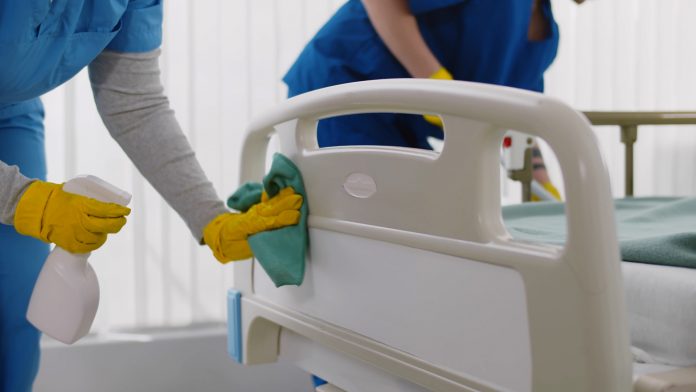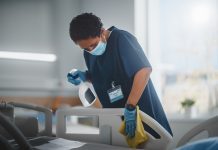
Understanding the correct cleaning processes and protocols for different environments is integral to mitigating the threat of infectious diseases and maintaining high levels of patient care.
In 1742, a physician called Sir John Pringle was tasked with documenting the problems associated with military life. It resulted in the book, Observations on the Diseases of the Army, which outlined the importance of hygiene in patient care .
Pringle stated that there were two fundamental issues related to infection. The first was that inadvertent contact between medical professionals, the sick, and the instruments and surfaces they touched led to more instances of the same illness. The second was that the cause was not some mysterious ethereal phenomenon but an unseen one.
He was certain that infections were microbial in nature and that he could stop their spread by using a combination of chemicals, which he termed ‘antiseptic’. The solution was straightforward: keep hands, clothing, and environmental surfaces clean, and infections would be prevented.
From the frontlines of cleaning for health
Despite being over 250 years old, Sir Pringle’s efforts are still the theoretical basis of current infection prevention measures. Yet, the relative simplicity of infection prevention principles is unfortunately not as easy to accomplish.
Today, healthcare facilities are an assemblage of departments, each responsible for carrying out certain roles. To prevent Healthcare-Associated Infections (HAIs) from occurring, there are usually two departments involved on the frontline of battle.
The first is the infection prevention and control department (IPC), staffed with academically trained professionals. The other is the Environmental Services Department (ES), comprised of professionals who do the actual cleaning of the institution. Their job is to work together towards a similar goal; to reduce the risk of infectious disease. Unfortunately, as history has shown, this is where the problems start.
When hospitals want to compete in their market, leaders often look to the latest 128-slice, 3D CT scanner, a Da Vinci robot to perform intricate surgeries, recruit the best surgeon, or begin a new service line with the best ROI. While these capital expenditures and improvements might attract publicity for a fleeting moment, the board of directors must consider a different, low-cost option that provides the best chance to improve patient care and satisfaction, reduce HAIs, and improve the bottom line: the Environmental Services Department.
The literature is replete with articles and studies in infection prevention annals extolling the virtues of various environmental hygiene products, processes, and programmes to reduce HAIs in healthcare. The one missing ‘p’ is the people who work hard, do a dirty (sometimes disgusting) and repetitive job, and make less than a living wage while providing a safe, clean, and disinfected environment for patients and staff, the people of the Environmental Services Department.
When keeping pathogenic organisms safe on environmental surfaces, the least educated and lowest-paid people in the hospital must eliminate those dangerous bacteria. This is the level in the hospital hierarchy where you have the least investment, the least status, and the least respect.
The impact of HAIs implies prolonged hospital stays, long-term disability, increased resistance of microorganisms to antimicrobials, a massive additional financial burden for health systems, high costs for patients and their families, and excess deaths. In Europe, HAIs cause 16 million extra days of hospital stay, cause 37,000 attributable deaths and contribute to an additional 110,000 yearly.
In Canada, rising infection rates in hospitals are causing unnecessary suffering and death and are taxing the healthcare system as well as patients and families.
- Each year in Canada, more than 220,000 HAIs result in 8,500-12,000 deaths, and the rates are rising;
- One in nine hospital patients in Canada contracts a healthcare-associated infection; and
- Infections are the fourth leading cause of death in Canada.
Many hospitals and healthcare organisations have consistently held low regard for the ES department. Too often, housekeeping or environmental services workers are thought to be expendable (anyone knows how to clean a toilet and mop a floor, right?) and difficult to educate because English is not their first language. To those organisations, the thought is, ‘what if I educate them and they leave?’ But, far worse than that, ‘what if you do not educate them and they stay?’
Consistent terminology is not only important at scientific levels but also vitally important for communicating with those on the frontlines of infection prevention, the Environmental Services Associates (ESA). When educating ESAs, we must use terms that are easily understood. But it is also important that your written policies and procedures use similar, professional terminology unique to our profession.
Rethinking the language around cleaning
The unqualified use of the term ‘cleaning’ should be avoided in communicating hygiene practices with the cleaning staff. Terms other than cleaning could define this process and state of hygienic cleaning (hygienically clean), cleaning and disinfection (process or processing).
I would propose replacing ‘clean’ or ‘cleaning’ with ‘hygienic cleaning’ to refer to any process intended to reduce the number of pathogens on surfaces to an acceptable safety target level, which makes it fit for purpose, and ‘hygienically clean’ to define the state of that surface after hygienic cleaning.
Efficacious hand hygiene involves these elements: clean running water, soap, agitation, time, attention to places where germs might hide, thorough rinsing with water and drying with a clean paper towel.
When it comes to professionally cleaning surfaces, we need to eliminate the term ‘clean when visibly soiled’. Increasingly, the data show that potentially unsafe levels of pathogens can remain on visibly clean surfaces. Faecal matter the size of a pinhead contains sufficient infective material to transmit C. diff. When your staff is instructed to clean ‘visibly soiled’ touchpoint surfaces, are they looking for soil the size of a pinhead? No. That is why you should eliminate that term from your education and training along with policies and procedures.
It needs to be made clear that, in hygiene practice, a surface can only be considered safe if it has been subjected to a validated hygiene process, which has been carried out in the prescribed manner. Visible cleanliness alone is not sufficient to judge whether a surface is safe.
Process and processing in patient care
The term ‘process’ includes cleaning and disinfecting a piece of patient care equipment or a patient care area using a micro-denier cloth or flat mop (as appropriate) and a hospital-approved disinfectant. We do not clean a patient’s room; we process a patient’s room. We do not clean and disinfect an operating room; we process it.
A disinfectant is a substance, or mixture of substances, capable of destroying or irreversibly inactivating pathogenic (disease-causing) organisms, but not necessarily spores, present on a hard, non-porous surface. It is recommended that only hospital-grade disinfectants be applied to pre-cleaned surfaces. All disinfectants sold in America must have a US EPA registration number because chemical disinfectants fall under the FIFRA (Federal Insecticide, Fungicide and Rodenticide) regulations. Just because a disinfectant has a registration number on its label does not mean it is safe to use. Read and follow label instructions for use, necessary PPE, mixing, contact time, kill claims, hazard warnings, water hardness, etc.
It is recommended that the surface is rinsed with clear water after the contact time has been observed. Many disinfectants are corrosive to surface materials and need to be rinsed. Also, most disinfectants leave a visible residue on the surface that should be removed.
The CDC defines disinfecting as a process that eliminates many or all pathogenic microorganisms, except bacterial spores, on hard non-porous surfaces. In healthcare settings, objects are usually disinfected by liquid chemicals called disinfectants.
Factors that affect the efficacy of disinfection include prior cleaning of the object; soil load present; type and level of microbial contamination; concentration of and exposure time to the germicide; physical nature of the object (e.g., crevices); and the presence of biofilm.
Removing soil
Washing or scrubbing a surface physically removes soil, and with the soil goes the ‘bad guys’. The guiding principle is always to remove germs, if possible, rather than kill them. When necessary, use the least amount of the mildest chemical or other product that will do the job because stronger often means more toxic to people and more corrosive to the surface being processed.
If hygiene procedures are to be effective, a determination needs to be made regarding not only product efficacy but, more importantly, whether the process results in what we want to achieve—namely, environmental surfaces which are hygienically clean (fit for purpose), as sufficient to break the chain of infection transmission.
Hygienic cleaning in patient care
Hygienic cleaning refers to any process intended to reduce the number of pathogens on surfaces to an acceptable safety target level, making it fit for purpose and hygienically clean. The terms processing and hygienic cleaning can be used interchangeably.
Hygienically clean: the state of a surface after hygienic cleaning or processing.
Hygienic cleaning and processing include four sequential steps:
1) Process the surface with a Ph-neutral, general-purpose cleaning product and micro-denier cleaning cloth that can be laundered according to CDC guidelines for processing patient linens;
2) Apply a hospital-approved disinfectant with micro-denier microfibre cleaning products and allow the disinfectant to air dry for 60-90 seconds;
3) Rinse the dry surface with clean water and wipe dry with micro-denier microfibre cleaning products; and
4) It needs to be made clear that, in hygiene practice, a surface can only be judged to be ‘safe’ if it has been subjected to a validated hygiene process carried out in the prescribed manner (steps one to three).
It is important to achieve even and thorough surface coverage to result in even and complete hygienic cleaning. Multiple studies have shown that 10-50% of the surfaces in patient rooms colonised or infected with C. diff, MRSA and VRE are contaminated with these pathogens. A lack of thoroughness in hygienically cleaning contaminated surfaces in patient rooms has been linked to an overall 120% increased risk of infection to the next occupant.
Keeping hospitals and healthcare facilities clean is a crucial patient care and safety issue. There is now enough evidence to demonstrate that maintaining the hygiene of the hospital environment helps prevent infections. Still, good interventional studies are rare, and the quality of products and methods available are too varied. Additionally, ESAs are often relatively untrained, unmotivated, underpaid, and under-appreciated by other professional staff in the hospital.
When these issues are coupled with the severe labour shortage phenomenon in 2021-23, environmental services leaders struggle with a situation that creates an undesirable situation regarding healthcare worker safety and patient care.
It is time for a cleaning revolution
A clean hospital might not be a sanitary hospital, but a sanitary hospital is always a clean hospital. Cleaning and disinfection of environmental surfaces and equipment are essential to an infection prevention programme. There is enough evidence in the scientific literature that environmental contamination plays an important role in transmitting several key healthcare-associated pathogens, including methicillin-resistant Staphylococcus aureus (MRSA), vancomycin-resistant Enterococcus (VRE), Acinetobacter spp., norovirus, and C. diff. All these pathogens have been demonstrated to persist in the environment for days (in some cases months), frequently contaminate surfaces in rooms of colonised and infected patients, transiently colonise the hands of healthcare personnel (HCP), be transmitted by HCP and cause outbreaks in which environmental transmission was deemed to play a role.
Cleaning and disinfection practices in healthcare settings
Each hospital or healthcare setting must have policies and procedures that ensure:
- Cleaning is a continuous event in the healthcare setting
- Cleaning procedures incorporate the principles of infection prevention and control (i.e., the separation between ‘clean’ and ‘dirty’);
- Cleaning standards, frequency and accountability for cleaning are clearly defined (i.e., who cleans, what do they clean, and when do they clean it?);
- Cleaning schedules ensure that no area or item is missed from routine cleaning and disinfection; and
- Statutory requirements of local, state, and federal governments are met in relation to:
- The safe disposal of regulated medical waste
- The safe handling of linen (soiled and clean)
- Food hygiene
- Pest management
Routine healthcare cleaning practices
Routine cleaning practices are practices that are used wherever cleaning is done. Routine cleaning is necessary to maintain a specific measure of cleanliness, i.e., hotel clean or hygienically clean. Routine cleaning practices must be effective and consistent to reduce the transmission of microorganisms.
The frequency of cleaning is dependent upon the risk classification of the surface or item to be cleaned. For example, a telephone in a patient’s room should be cleaned at least daily because it may be touched by many individuals, including those with infectious illnesses. A telephone in a manager’s office may only be cleaned periodically as it is used primarily by one person with no known illness.
‘Hotel clean’ is a measure of cleanliness based on visual appearance. We do not hide or brush aside dust and waste and say we are cleaning. We must remove and dispose of them too. That includes dust and soil removal, waste disposal and cleaning of windows and touchpoints. Hotel clean is cleaning to the point that it protects human health in general, but it still has some microbial contamination. The risk of the disease still exists, but it is at an acceptable risk level.
At a minimum, cleaning must always achieve a state of ‘sanitation’. An unsanitary condition poses a likely health risk. The purpose of cleaning is to correct the risky condition. Therefore, if a risk has not been improved to a level deemed sanitary, cleaning has not been accomplished. Cleaning alone does not kill germs. But, removing the germs decreases their number to an acceptable risk level.
‘Hotel clean’ criteria
- Floors and baseboards are free of stains, visible dust, splashes, and old floor finish
- Walls, ceilings, and doors are free of visible dust, gross soil, streaks, spider webs and handprints;
- All horizontal surfaces are free of visible dust or streaks (includes furniture, window ledges, overhead lights, phones, picture frames, carpets, etc.);
- Bathroom fixtures, including toilets, sinks, tubs, and showers, are free from streaks, soil, stains, and soap scum;
- Mirrors and windows are free of dust, smudges, handprints, and streaks;
- Dispensers are free of dust, soiling and residue and replaced/replenished when empty;
- Vending machines, appliances such as microwave ovens, refrigerators, coffee machines, etc., are free of dust, soiling and stains;
- Waste is disposed of on a frequency that matches the traffic/usage in the area; and
- Items that are broken, torn, cracked, or malfunctioning is reported to the appropriate department for repair or replacement.
Hygienically clean is a measure of cleanliness routinely maintained in patient care areas of the hospital. ‘Hospital clean’ is ‘hotel clean’ with the addition of disinfection, increased frequency of cleaning, auditing, and other infection prevention/control measures in client/patient areas.
‘Hygienically clean’ criteria
Hygienically clean consists of ‘hotel clean’ plus the processing of high-touch surfaces in client/patient care areas with a hospital-approved disinfectant. Non-critical patient care equipment is also cleaned and disinfected between clients/patients.
Cleaning practices are periodically monitored and audited with feedback and education (as needed).
In 1742, Dr Pringle wrote that by keeping hands, clothing and environmental surfaces clean, infections would be prevented. Simple cleaning of the environmental surfaces may be one of our key defences in the future battle against infectious diseases. With antibiotic-resistant organisms proliferating on common touchpoints for up to 56 or more days, the study of cleaning and measuring cleanliness is becoming all-important.
One of the most salient arguments for better, more thorough cleaning and disinfection is ‘one well-trained, conscientious cleaning professional given the right tools and enough time to perform their job to a standard will prevent more disease than a room full of doctors can cure.’ Prevention trumps a cure every time.












